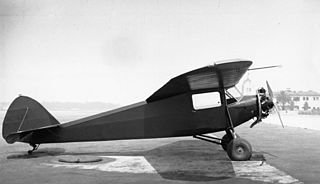Related Research Articles

Grover Cleveland Loening was an American aircraft manufacturer.

The Metal Aircraft Flamingo was a monoplane produced in Cincinnati, Ohio by the Metal Aircraft Corporation in the 1930s.
Leeon D. Davis was an American aircraft designer, noted for his homebuilt aircraft.

The Flaglor Scooter is an unusual light aircraft designed in the United States in the mid-1960s and marketed for homebuilding.

Berliner-Joyce Aircraft was an American aircraft manufacturer.
Parks College of Engineering, Aviation and Technology was a college within Saint Louis University. It formed from the pre-existing Parks Air College, founded by Oliver Parks in 1927. Its successor is the Oliver L. Parks Department of Aviation Science within the SLU School of Science and Engineering at Saint Louis University.
The W.A.R. P-47 Thunderbolt is a half-scale homebuilt replica of a P-47 Thunderbolt fighter, produced as a kit by War Aircraft Replicas International, Inc. for amateur construction.

Maryland's first aeronautical event was the flight of 13-year-old Edward Warren from Baltimore in Peter Carne's tethered hot air balloon in 1784.

The Church Midwing JC-1, a.k.a. Church Mid-Wing Sport, is a midwing racing aircraft designed by James Church using the fuselage of a Heath aircraft.

The United States capital, Washington, D.C., has been the site of several events in the nation's history of aviation, beginning from the time of the American Civil War, often for the purpose of promoting the adoption of new aeronautical technologies by the government. It has also been home to several governmental and civilian aircraft manufacturers and aviation organizations, and several aerospace contractors.
Art Chester (1899–1949) was an American barnstormer and air racer of the 1930s and 1940s. Chester was instrumental in the development of the Menasco Pirate and Buccaneer inverted inline engines. He was also the designer of the propeller spinner and engine front cowling for the North American North American P-51 fighter.
Victor H. Roos was an American entrepreneur and the founder or co-founder of several early aircraft companies.

The Kari-Keen 90 Sioux coupe is a two-seat cabin monoplane.

The Laird Solution, also called the Laird LC-DW Solution, Laird LC-DW300 Super Solution and Laird LC-DW500 Super Solution, was touted as being the "solution" to the problem of the Travel Air Mystery Ship. The Solution won the 1930 Thompson Trophy race days.

The EAC-1 is a folding-parasol wing aircraft developed by the Engineers Aircraft Corporation of Stamford, Connecticut.

The Nicholas-Beazley NB-3, or Barling NB-3, is a two-seat, training aircraft of the 1920s.
The Mohawk M-2-C Chieftain is a prototype light twin aircraft from the Mohawk Aircraft Company.
Yunker Aircraft Company was an American aircraft manufacturer of the late 1920s
Swen (Sven) Swanson was a Swedish aircraft designer. He designed aircraft for various aviation companies in the United States and also designed prototype and experimental airplanes. He was known as an innovative aircraft designer. He later worked in partnership with Ole Fahlin. Swanson started designing airplanes while in his teens and by the time he was in college he had designed his third airplane. He founded the Swanson Aircraft Company Inc. and became its chief engineer and president. While working for his own company he designed and built the Swanson W-15 Coupe. He has been described as a "brilliant man of great capabilities and extreme modesty".

The Swanson Coupe Model W-15 was a high-wing, cantilever-type monoplane produced in 1931 by Swedish aircraft designer and manufacturer Swen Swanson. Its design was considered innovative and the aircraft was viewed as part of a trend of producing safe and economical airplanes, which would appeal especially to automobile drivers. The Swanson Coupe was also designed to function as trainer aircraft.
References
- ↑ Aviation. 15 March 1930.
{{cite journal}}: Missing or empty|title=(help) - ↑ Sioux City Spirit of Progress. May 1929.
{{cite journal}}: Missing or empty|title=(help) - ↑ "[Untitled]". Aero Digest. Vol. 18, no. 1. Aeronautical Digest Publishing Corporation. January 1931. p. 108. Retrieved 6 July 2021.
- ↑ Skyways. July 1999.
{{cite journal}}: Missing or empty|title=(help)